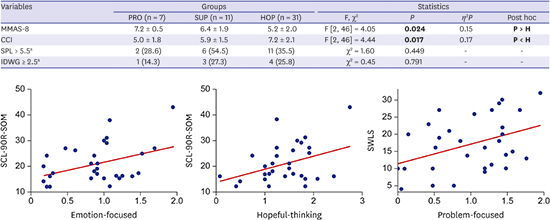1. Clark S, Farrington K, Chilcot J. Nonadherence in dialysis patients: prevalence, measurement, outcome, and psychological determinants. Semin Dial. 2014; 27(1):42–49.

2. Schmid H, Hartmann B, Schiffl H. Adherence to prescribed oral medication in adult patients undergoing chronic hemodialysis: a critical review of the literature. Eur J Med Res. 2009; 14(5):185–190.

3. Saran R, Bragg-Gresham JL, Rayner HC, Goodkin DA, Keen ML, Van Dijk PC, et al. Nonadherence in hemodialysis: associations with mortality, hospitalization, and practice patterns in the DOPPS. Kidney Int. 2003; 64(1):254–262.

4. DiMatteo MR. Variations in patients’ adherence to medical recommendations: a quantitative review of 50 years of research. Med Care. 2004; 42(3):200–209.
5. Kugler C, Maeding I, Russell CL. Non-adherence in patients on chronic hemodialysis: an international comparison study. J Nephrol. 2011; 24(3):366–375.

6. Ghimire S, Castelino RL, Lioufas NM, Peterson GM, Zaidi ST. Nonadherence to medication therapy in haemodialysis patients: a systematic review. PLoS One. 2015; 10(12):e0144119.

7. Weiten W, Dunn DS, Hammer EY. Psychology Applied to Modern Life: Adjustment in the 21st Century. 11th ed. Belmont, CA: Wadsworth Publishing; 2014.
8. Gremigni P, Bacchi F, Turrini C, Cappelli G, Albertazzi A, Bitti PE. Psychological factors associated with medication adherence following renal transplantation. Clin Transplant. 2007; 21(6):710–715.

9. Folkman S, Lazarus RS. Manual for the Ways of Coping Questionnaire. Palo Alto, CA: Consulting Psychologists Press;1988.
10. Lee JH, Kim JH. Relations of perceived stress, cognitive set, and coping behaviors to depression: a focus on freshmen's stress experiences. Korean J Couns Psychother. 1988; 1(1):25–45.
11. Brito DC, Marsicano EO, Grincenkov FR, Colugnati FA, Lucchetti G, Sanders-Pinheiro H. Stress, coping and adherence to immunosuppressive medications in kidney transplantation: a comparative study. Sao Paulo Med J. 2016; 134(4):292–299.

12. Garay-Sevilla ME, Porras JS, Malacara JM. Coping strategies and adherence to treatment in patients with type 2 diabetes mellitus. Rev Invest Clin. 2011; 63(2):155–161.
13. Weaver KE, Llabre MM, Duran RE, Antoni MH, Ironson G, Penedo FJ, et al. A stress and coping model of medication adherence and viral load in HIV-positive men and women on highly active antiretroviral therapy (HAART). Health Psychol. 2005; 24(4):385–392.

14. Ahmad MM, Al Nazly EK. Hemodialysis: stressors and coping strategies. Psychol Health Med. 2015; 20(4):477–487.

15. Al Nazly E, Ahmad M, Musil C, Nabolsi M. Hemodialysis stressors and coping strategies among Jordanian patients on hemodialysis: a qualitative study. Nephrol Nurs J. 2013; 40(4):321–327.
16. Niihata K, Fukuma S, Akizawa T, Fukuhara S. Association of coping strategies with mortality and health-related quality of life in hemodialysis patients: the Japan Dialysis Outcomes and Practice Patterns Study. PLoS One. 2017; 12(7):e0180498.

17. Wu PH, Lin YT, Lee TC, Lin MY, Kuo MC, Chiu YW, et al. Predicting mortality of incident dialysis patients in Taiwan--a longitudinal population-based study. PLoS One. 2013; 8(4):e61930.
18. Park JY, Kim MH, Han SS, Cho H, Kim H, Ryu DR, et al. Recalibration and validation of the Charlson comorbidity index in Korean incident hemodialysis patients. PLoS One. 2015; 10(5):e0127240.

19. Ambrosio L, Senosiain Garcia JM, Riverol Fernandez M, Anaut Bravo S, Diaz De Cerio Ayesa S, Ursua Sesma ME, et al. Living with chronic illness in adults: a concept analysis. J Clin Nurs. 2015; 24(17-18):2357–2367.

20. Kroenke K, Spitzer RL, Williams JB. The PHQ-9: validity of a brief depression severity measure. J Gen Intern Med. 2001; 16(9):606–613.
21. Cohen S, Williamson G. Perceived stress in a probability sample of the United States. In : Spacapan S, Oskamp S, editors. The Social Psychology of Health: Claremont Symposium on Applied Social Psychology. Newbury Park, CA: Sage;1988. p. 31–67.
22. Derogatis LR. SCL-90-R: Administration, Scoring & Procedures Manual-II for the R(evised) Version and Other Instruments of the Psychopathology Rating Scale Series. 2nd ed. Towson, MD: Clinical psychometric research, Inc.;1992.
23. Derogatis LR. SCL-90-R: Symptom Checklist-90-R: Administration, Scoring and Procedures Manual. 3rd ed. Minneapolis, MN: National Computer Systems, Inc.;1994.
24. Diener E, Emmons RA, Larsen RJ, Griffin S. The satisfaction with life scale. J Pers Assess. 1985; 49(1):71–75.

25. Morisky DE, Ang A, Krousel-Wood M, Ward HJ. Predictive validity of a medication adherence measure in an outpatient setting. J Clin Hypertens (Greenwich). 2008; 10(5):348–354.

26. Vélez-Vélez E, Bosch RJ. Illness perception, coping and adherence to treatment among patients with chronic kidney disease. J Adv Nurs. 2016; 72(4):849–863.
27. Carver CS, Scheier MF, Weintraub JK. Assessing coping strategies: a theoretically based approach. J Pers Soc Psychol. 1989; 56(2):267–283.

28. Frazier PA, Davis-Ali SH, Dahl KE. Correlates of noncompliance among renal transplant recipients. Clin Transplant. 1994; 8(6):550–557.
29. Leventhal H, Cameron L. Behavioral theories and the problem of compliance. Patient Educ Couns. 1987; 10(2):117–138.

30. Butt CM. Hope in adults with cancer: state of the science. Oncol Nurs Forum. 2011; 38(5):E341–E350.

31. Griggs S, Walker RK. The role of hope for adolescents with a chronic illness: an integrative review. J Pediatr Nurs. 2016; 31(4):404–421.

32. Madan S, Pakenham KI. The stress-buffering effects of hope on adjustment to multiple sclerosis. Int J Behav Med. 2014; 21(6):877–890.

33. Piccinelli C, Clerici CA, Veneroni L, Ferrari A, Proserpio T. Hope in severe disease: a review of the literature on the construct and the tools for assessing hope in the psycho-oncologic setting. Tumori. 2015; 101(5):491–500.

34. Smith AB, Rutherford C, Butow P, Olver I, Luckett T, Grimison P, et al. A systematic review of quantitative observational studies investigating psychological distress in testicular cancer survivors. Psychooncology. 2018; 27(4):1129–1137.

35. Karamanidou C, Clatworthy J, Weinman J, Horne R. A systematic review of the prevalence and determinants of nonadherence to phosphate binding medication in patients with end-stage renal disease. BMC Nephrol. 2008; 9:2.










 PDF
PDF Citation
Citation Print
Print




 XML Download
XML Download